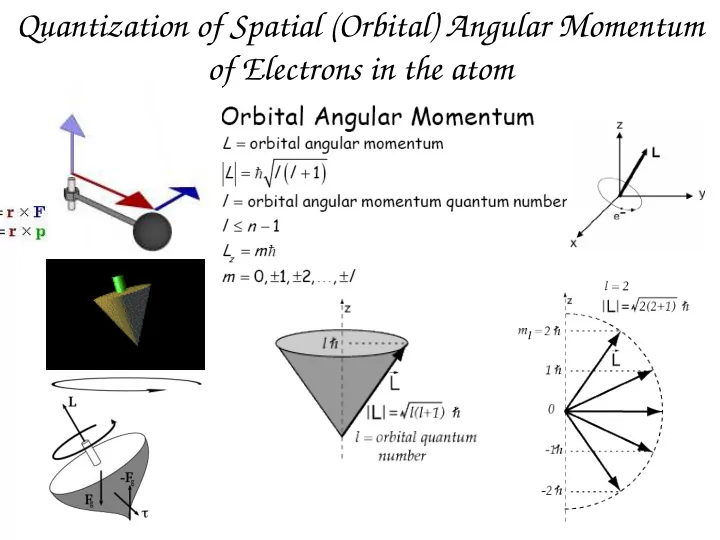

Quantization of Spatial (Orbital) Angular Momentum of Electrons in the atom
Na/Ag atoms: ns1: l=0: Zero Orbital Momentum For 1S electrons If electrons are classical, "spinning" particles, then distribution of their spin If electrons are classical, "spinning" particles, then distribution of their spin angular momentum vectors is taken to be truly random and each particle would angular momentum vectors is taken to be truly random and each particle would be deflected up or down by a different amount, producing an even distribution. be deflected up or down by a different amount, producing an even distribution. But electrons are deflected either up or down by a specific amount. But electrons are deflected either up or down by a specific amount.
Intrinsic angular momentum or “Spin” of an electron is quantized This can only mean that spin angular momentum is quantized!!! Electrons are spin1∕2 particles. Only two possible spin angular momentum, referred to as “spinup” (or α ) and “spindown” (or β ). The exact value in the z direction is m s = +ħ/2 or −ħ/2 . If this value arises as a result of the rotating particles, then they would have to be spinning impossibly fast Spin S( ω ); ω is unknown (internal) coordinate (NONCLASSICAL)
Implication of “Spin” on Hydrogen 1e wavefunctions: Spin Orbitals Introduce a “spin” component to each of the 1e WFs along with spatial components. This doubles the degeneracy of each level in hydrogenic atoms. 1e WFs with the inclusion of spin are now called SPIN ORBITALS. Introduction of spin results in the 4th quantum number For each electron: 3 spatial, and one for spin (4 th coordinate)
2e’ Spinorbitals: Indistinguishability TwoElectron Spin Functions for a pair of electrons in 1s (spatial orbital)? α α β β α β β α (1) (2) (1) (2) (1) (2) (1) (2) Wavefunctions must reflect the indistinguishability of electrons: No known experiments can differentiate between two electrons in the same spatial orbital; No observables of the system can change if coordinates of the two electrons are interchanged. µ Exchange of coordinates ℜ : Indistinguishibility ( ) µ [ ] 2 2 Ψ = Ψ ⇒ ℜ Ψ ≡ Ψ = ±Ψ (1,2) (2,1) (1,2) (2,1) (1,2) [ ] [ ] [ ] ℜ α α = α α = + α α (1) (2) (2) (1) (1) (2) ≠ [ ] [ ] [ ] ℜ α β = α β ± α β (1) (2) (2) (1) (1) (2)
Acceptable Spin Wavefunctions α α β β α β ⊗ β α ⊗ (1) (2) (1) (2) (1) (2) (1) (2) Both α (1) β (2) and α (2) β (1) distinguishes between electrons – CAN NOT BE ACCEPTABLE Spin functions What about α β ± β α (1) (2) (1) (2)? ℜ [ ] [ ] [ ] α β + β α = α β + β α ≡ α β + β α (1) (2) (1) (2) (2) (1) (2) (1) (1) (2) (1) (2) ℜ [ ] [ ] [ ] α β − β α = α β − β α ≡ − α β + β α (1) (2) (1) (2) (2) (1) (2) (1) (1) (2) (1) (2) α α (1) (2) β β − (1) (2) symmetric even f n ( ) α β + β α (1) (2) (1) (2) α β − β α − (1) (2) (1) (2) anti symmetric - odd f n ( )
6 th Postulate in Quantum Mechanics (Pauli’s) Exclusion Principle: Independently derived by Dirac and Heisenberg Complete wavefunction (spatial and spin) of system of identical fermions (electrons) must be antisymmetric with respect to interchange of the coordinates (spatial and spin) of any two particles. Postulate 6: Complete wavefunctions describing a Manyelectron system must be antisymmetric under the exchange of coordinates of any two electrons.
Recommend
More recommend